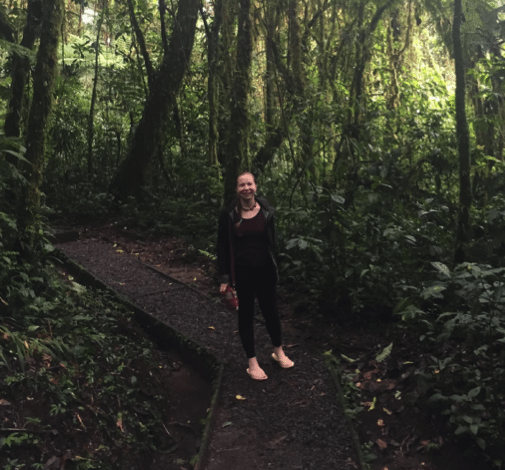Diana McLaughlin just finished her sophomore year as a Music Education and Spanish double major at the University of Massachusetts Amherst. She is in Costa Rica as a music volunteer from May until July 2016.
I arrived in San José, Costa Rica three weeks ago, and am now halfway done with my 6-week music volunteering experience. In my first week, I took Spanish classes in the morning and volunteered at Sion Institute of Music, a privately run, extracurricular music school, in the afternoons. There, I have 2 classes of students, ages 4 – 11, that are learning music fundamentals so that they can choose an instrument and continue with private lessons at the school after I return to the U.S. Every class starts with singing. Sometimes I sing solfege notes (do re mi), and the kids repeat, and sometimes we learn a song, but the first thing I always sing is “¿Cómo estás?” and every student answers, singing: “Estoy bien.” During class, the students learn rhythms, how to read music, and how to play the recorder. We sing, clap, and dance frequently. I never thought that I would enjoy teaching kindergarten age kids until I got to design this class. I love it! Every class ends by listening to music and the kids draw a picture of how it makes them feel. This way, they are learning to connect with what they hear, and when they look at their peers’ drawings, they learn that the same music can mean many different things, depending on the listener.
These classes are my own; the school’s director oversees my work, but I teach everything. If you ever want to test your second language skills, younger kids are wonderful because they can be completely unforgiving, especially of terrible English accents. 🙂
Despite the language, I thought that my biggest challenge would be organizing activities for the students and making coherent lessons because although I am a Music Education major, I still have minimal experience planning classes.
Fast forward to Week Two.
I finished my week of Spanish classes, and began to spend my mornings at a new placement, although I still teach at Sion in the afternoons. SIFAIS is a non-profit project designed to empower students through music, art, and sports. It is located in La Carpio, one of the most underprivileged neighborhoods in Costa Rica. La Carpio is in San José, but is surrounded by 2 rivers and a landfill. The area benefits from humanitarian outreach programs and volunteer work, but there is still a lot to be done. Some streets are still unpaved and so narrow that a car can barely fit down them. Somebody from our language school takes the other volunteers and me because they don’t want us to take the bus. Driving down the streets, it is clear that there is a need for arts empowerment.
My first week there, two other volunteers and I went together and about ten students, ages 8 – 11, greeted us. We started by sitting in a circle and singing together. In college, sight singing is extremely difficult for me, and I was never really sure how I would handle my insecurities when I started teaching. But now, with ten kids sitting restlessly waiting for instruction, uncertainty is not an option. I either sing or they lose focus. Same thing when a student walked up to me with a violin at the end of the week. The student showed a genuine interest and asked me for help, so it didn’t matter that I was desperately trying to recall my one semester of a strings method class.
As a music ed major, I need to have experience in every aspect of music. When I graduate, I can go on to teach band, orchestra, chorus, etc. Even in the U.S. some schools only have one music teacher, so although I am a French horn player, I know that teaching violin is a very real possibility in my future, and my experience at SIFAIS is preparing me well for that. I teach something different everyday, such as strings, voice, and piano. I think that musicians are inherently very aware of their weaknesses, so even though I am technically able to teach strings (or voice), it terrified me at first to think that I had one semester of classes in each respective area and here I am actually teaching. But in that sense, it is also amazing; this experience is real life. Sometimes I think that the kids deserve better: someone who actually has years of experience teaching and singing, or at least someone who can play more than “Twinkle Twinkle Little Star” (“Estrellita” en español) on the violin. But I’ve realized that right now, I might the best that the kids have, so I need to act like it. I challenged myself to use this as a learning experience, because this will not be the last time that I teach any of these instruments. So I have a lot of violin to learn, although the kids act like I’m super cool when I play “Estrellita” for them.
I have also been able to incorporate my horn. Sometimes I play for the students and they dance based on the music that I’m playing, but a lot of the time, they just want to play themselves.
I am very thankful for the other volunteers that are here with me. We all have different backgrounds (thankfully some play piano and/or string instruments), so we work together, learn together, get stuck in torrential downpours together, and they only make fun of me a little bit when I read the map wrong and get us lost in the city.
And of course the kids make it all worth it.
And yes, when I’m not at school, I’m being a total tourist.
